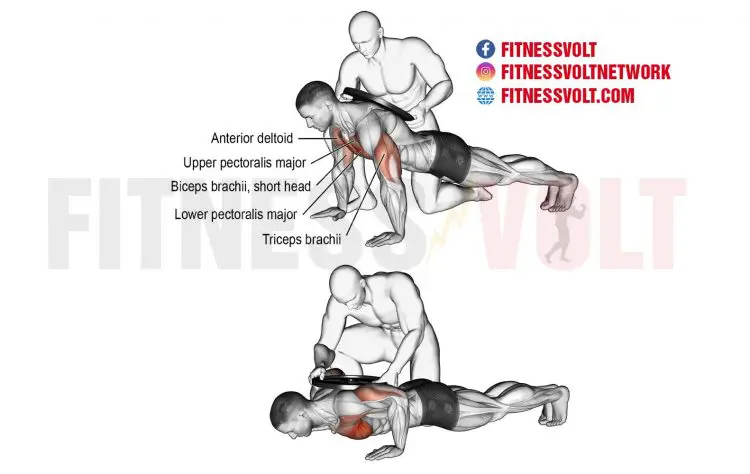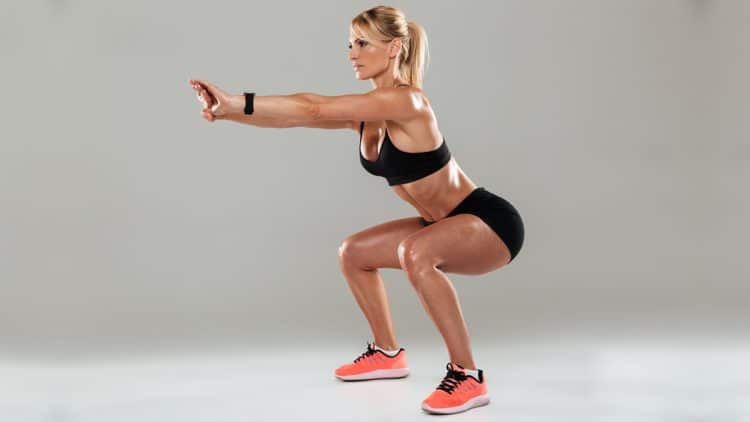The humble push-up is arguably the most widely performed exercise in the world. Just about everyone who works out has done push-ups – from athletes to special forces soldiers to kids in PE classes. They’re the cornerstone of calisthenics – a form of training that exclusively uses bodyweight exercises.
Push-ups are among the safest and most effective ways to train your upper body pushing muscles. You can do them anywhere and anytime, and they’re so straightforward that most people can master them within a couple of workouts.
But, there is a disadvantage to push-ups – your body weight.
Sure, there are ways to make push-ups more challenging, but ultimately, your body weight is your main form of resistance. That means the most obvious way to progress your push-up workouts is to do more reps.
That’s okay initially, but as you get stronger, you could find yourself doing sets of 30, 40, 50, or even 100 reps. Such high-rep sets are undoubtedly challenging, but they are also very time-consuming and, let’s be honest, pretty boring.
The good news is that you don’t have to limit yourself to bodyweight push-ups, and strapping on a weighted vest will take your push-up game to a new, higher level.
Level Up Your Fitness: Join our 💪 strong community in Fitness Volt Newsletter. Get daily inspiration, expert-backed workouts, nutrition tips, the latest in strength sports, and the support you need to reach your goals. Subscribe for free!
In this article, we explain why and how to do weighted push-ups and reveal some of the best weighted push-up alternatives.
Weighted Push-Ups – Muscles Worked
The weighted push-up is a compound exercise, which means it involves multiple muscles and joints working together. The main muscles trained during weighted push-ups are:
Pectoralis major
Known as the pecs for short, these are your chest muscles. The pecs are large, fan-shaped muscles and are responsible for horizontal flexion, flexion, and medial rotation of the shoulder joints.
Moving your hands in or out, and raising or lowering your feet, will affect different parts of your chest.
Triceps brachii
The triceps brachii is located on the back of your upper arm. Usually known just as the triceps, this muscle extends your elbow and also plays a part in shoulder joint extension. Weighted push-ups involve a lot of triceps engagement, especially when your hands are close together.
Deltoids
The deltoids are your shoulder muscles. There are three groups of deltoid fibers, usually known as heads: anterior (front), medial (side), and posterior (rear). The anterior head is the most active during weighted push-ups, and the medial and posterior heads work mostly as stabilizers, preventing unwanted movement.
Serratus anterior
This small but essential muscle helps keep your scapulae or shoulder blades flat against your ribs during weighted push-ups. It looks something like a serrated knife or saw blade, hence its name.
Located on the side of your lower pecs, weighted push-ups provide the serratus anterior with a great workout, and when well developed, this muscle can add a lot to your upper body aesthetics.
Core
Core is the collective term for the muscles of your midsection, i.e., the rectus abdominis, obliques, and transverse abdominis. Together, these muscles contract inward to create intra-abdominal pressure, stabilizing your lumber spine during weighted push-ups.
All types of push-ups are like a moving plank, but weighted push-ups are especially core-centric, as you need to support more weight.
Quadriceps and gluteus maximus
There is no denying that weighted push-ups are an upper-body exercise. However, supporting more weight means your lower body also gets a small but beneficial workout.
You’ll need to forcefully engage your quadriceps, located on the fronts of your thighs, to prevent your knees from bending. You’ll also need to use your gluteus maximus, or glutes for short, to stabilize your hips.
Tensing these muscles will help steady your lower body so you can use more weight or do more reps.
How to Do Weighted Push-Ups
There are several different ways to load weighted push-ups:
Weighted Vest
Weighted vest this is arguably the most convenient way to do weighted push-ups. Simply put the vest on, tighten it up, and get to work. Most weighted vests are adjustable, comfortable, and can be used for various upper and lower body exercises.
A loaded backpack
No weight vest? No problem! Just load some water bottles, books, or bricks into a rucksack, put it on your back, and get to work. On the downside, you may find the weight moves around during your workout.
A weight plate
You’ll need a partner to help you with this method. Simply get into the push-up position and ask your training buddy to gently rest a weight plate on your upper back. Providing you move slowly and smoothly, the weight should remain in place. Get your partner to remove the plate at the end of your set.
Dip belt
A dip belt to do weighted push-ups with a dip belt, you’ll need to place your hands and feet on raised surfaces, so the weight doesn’t touch the floor at the bottom of each rep. However, this low-tech method is an excellent way to make push-ups more challenging, and you don’t need a partner to do it.
Chains
This is arguably the most badass way to do weighted push-ups! Drape a weighted chain over your upper back/neck and get repping. However, weighted chains can be uncomfortable, and getting them into position on your own is not easy.
Resistance bands
Resistance bands no chains? No problem! You can get a similar effect with resistance bands. Simply loop the band over your upper back and hold it in your hands. However, the load will increase as you extend your arms and decrease as you bend them. That said, this is a very portable way to make push-ups more challenging.
Manual resistance
Manual resistance for this final method, just ask your training partner to push down on your upper back as you do your push-ups. While you won’t be able to quantify how much extra resistance you are lifting, this low-tech method will provide your muscles with plenty of overload.
Get more from weighted push-ups while keeping your risk of injury to a minimum by following these guidelines:
- Select your preferred loading method. Go lighter than you think – a little weight goes a long way!
- Squat down and place your hands on the floor, slightly wider than shoulder-width apart. Your fingers should be pointing forward.
- Keeping your core braced, walk your feet out and back until your legs and body are straight. Pull your shoulders down and back. Rotate your elbows in toward your sides. Imagine you are screwing your hands into the floor. This will increase shoulder stability and protect your joints from wear and tear. Lengthen your neck, tuck your chin in, and look straight down at the floor.
- Keeping your body straight, bend your arms and lower your chest to within an inch of the floor. Keep your upper arms close to your sides. Pause for a second.
- Drive your hands into the floor and push yourself back up, so your arms are extended but not locked.
- Reset your core and repeat.
Pro tips:
- Low to moderate reps work best for weighted push-ups, i.e., 5-15. Leave the high reps for bodyweight push-ups.
- Start with about 10% of your body weight and increase from there. This should be sufficient for most lifters.
- Use push-up handles if you find weighted push-ups hurt your wrists. Push-up handles make it easier to keep your wrists straight.
- Experiment with the width of your hands to see what works best for you. A narrower grip is more triceps-dominant but usually more shoulder-friendly.
- Brace your core BEFORE walking your feet out and back to ensure your spine is stabilized and protected.
- Imagine you are pushing the floor away from you. This cue can help maintain better weighted push-ups form, and help you pump out more reps.
Weighted Push-Up Benefits
Not sure if weighted push-ups are the right exercise for you? Consider these benefits and then decide!
A very functional exercise
Weighted push-ups work almost your entire body, teaching you how to use all your major muscles to generate force. As such, they closely mimic the demands of pushing, punching, throwing, and other outside-of-the-gym activities. They’re much more functional than most freeweight exercises, including bench presses.
Safe even if you train to failure
Bench pressing to failure is a recipe for disaster. If the bar gets stuck on your chest, you will struggle to get out from under it. That’s why bench presses should always be performed with a spotter or in a power rack.
However, with weighted push-ups, there is no such danger, and you can train to failure in relative safety.
A viable alternative for the bench press
If you train at home, you may not have enough space or the budget for a bench press station, barbell, and weights.
The good news is that weighted push-ups work all of the same muscles and can be progressed in the same way to build muscle size or strength. As an added advantage, most loading methods for weighted push-ups can also be used with different exercises, e.g., weighted pull-ups, weighted squats, weighted lunges, etc.
Read more about weighted calisthenics here.
Lots of variations to try
There are loads of different ways to do push-ups, and most of them can be done weighted. There is no reason to get stuck in a workout rut when there are so many variations to choose from! Add weight to your favorite push-up exercises to hit your chest, shoulders, and triceps from a range of angles.
Do low-rep training to build strength
While you can build muscle size with high-rep sets, the most effective way to get stronger is with low reps and heavy weights, typically 1-5 reps using 85% or more of your one repetition maximum.
Bodyweight push-ups can build bigger muscles and muscular endurance, but you’ll need to go heavier if you want to develop strength with push-ups. Weighted push-ups can help keep you in that 1-5 rep range for building strength.
Engage more muscles
Compared to the ever-popular bench press, weighted push-ups involve more muscles. Your legs and core are very active during weighted push-ups, and, without a bench supporting you, you’ll need to use your upper back to stabilize your shoulders. This means that weighted push-ups can potentially burn more calories, which may be beneficial if you are training for weight loss.
Drawbacks
While weighted push-ups are a mostly beneficial exercise, there are also a few drawbacks to consider:
Level Up Your Fitness: Join our 💪 strong community in Fitness Volt Newsletter. Get daily inspiration, expert-backed workouts, nutrition tips, the latest in strength sports, and the support you need to reach your goals. Subscribe for free!
You need to find a way to add weight to push-ups
One of the best things about regular bodyweight push-ups is that you don’t need any extra equipment to do them. Just drop to the floor and get to work! Weighted push-ups are a bit more involved, and you’ll need to find a way to load your body to do them.
Weighted vests are an excellent investment but can be expensive. Dip belts work well for weighted push-ups, but the setup can be a bit convoluted. A weighted backpack is a cheap option, but it probably won’t be very comfortable.
In short, weighted push-ups are a little less convenient than the bodyweight variation.
Your form may change
Adding weight to push-ups may cause you to modify your technique to accommodate the extra load. For example, it may reduce your range of motion, or you may find your hips dropping out of alignment, putting extra stress on your lower back.
Either way, you should endeavor to perform push-ups the same way whether you use added weight or not. In fact, with weight, you should accentuate your form to make the exercise as safe as possible, i.e., core braced, body straight, and shoulders packed.
More joint stress
Weighted push-ups are invariable harder on your joints than the bodyweight version. If you experience pain in your wrists, shoulders, elbows, or lower back, you should use less weight or skip this exercise entirely.
5 Weighted Push-Up Variations and Alternatives
Weighted push-ups are a highly effective upper-body exercise, but that doesn’t mean you need to do them all the time. There are several variations and alternatives you can use to keep your workouts productive and interesting:
1. Deficit weighted push-ups
Deficit push-ups involve doing your reps with a larger-than-usual range of motion. This increases time under tension and makes each rep more demanding. This is also a good option if you have a bulky weighted vest that otherwise stops you from lowering your chest all the way to the floor. However, this variation does put more stress on your shoulder joints.
Steps:
- Place weight plates, push-up handles, parallettes, or yoga blocks on the floor, slightly wider than shoulder-width apart.
- Using your preferred loading method, put your hands down and walk your feet back, so your body and arms are straight. Brace your core and pack your shoulders down and back.
- Bend your arms and lower your chest down between your hands. Get a slight stretch in your pecs.
- Push yourself back up and repeat.
Muscles targeted:
- Primary: Pectoralis major, triceps, deltoids.
- Secondary: Core.
Benefits:
- A more challenging exercise than weighted push-ups with your hands on the floor.
- Good for increasing shoulder mobility.
- Increased range of motion means greater pec and triceps activation.
Tips:
- Increase your range of motion as you get used to this exercise.
- Pause at the bottom of each rep for 2-3 seconds to make deficit push-ups more effective.
- Descend slowly, pause, and then explode upward for the ultimate deficit push-up workout.
2. Decline weighted push-ups
Decline weighted push-ups put even more weight onto your hands. The higher your feet, the harder this exercise becomes. Elevating your feet also increases upper chest engagement. However, if you lift your feet too high, you’ll probably feel this exercise more in your deltoids than your pecs.
Steps:
- Stand with a weight bench or plyo box behind you. Place your hands on the floor and your feet on the bench/box. Brace your abs and pack your shoulders back and down.
- Bend your elbows and lower your chest to within an inch of the floor.
- Push yourself back up and repeat.
Muscles targeted:
- Primary: Pectoralis major, triceps, deltoids.
- Secondary: Core.
Benefits:
- More weight on your arms for a more demanding workout.
- Increases upper chest engagement.
- An excellent way to get a tougher workout from a lighter weighted vest.
Tips:
- Increase the height of your step to put more weight on your arms.
- Combine this exercise with deficit push-ups for a much more intense upper-body workout.
- Move from decline weighted vest push-ups to regular weighted push-ups for a muscle-building mechanical drop set.
3. Weighted Diamond Push-Ups
Diamond push-ups are so-called because, with your hands close together, your fingers form a diamond shape. All weighted push-up variations work your triceps, but puting your hands together makes your triceps work harder. This also means you can’t use your pecs as much, so this is a very demanding exercise. Adjust your weights accordingly!
Steps:
- Place your hands on the floor, so your thumbs and first fingers are touching. Walk your feet out and back, so your legs and body are straight. Brace your core and pack your shoulders down and back.
- Bend your arms and lower your chest down to the backs of your hands.
- Push yourself back up and repeat.
Muscles targeted:
- Primary: Triceps, pectoralis major, deltoids.
- Secondary: Core.
Benefits:
- An excellent triceps builder.
- More demanding than weighted push-ups done with wider hands.
- May increase inner pec engagement.
Tips:
- This variation is HARD, so don’t go too heavy too soon.
- Use narrow push-up handles or parallettes if the diamond position hurts your wrists.
- Keep your upper arms tucked into your ribs to maximize triceps engagement.
4. Gymnastic ring weighted push-ups
Gymnastic rings are incredibly versatile, and with them, you can train virtually every muscle in your body. Using rings increases your range of motion and also introduces instability to your workout, both of which make your chosen exercises considerably harder. Weighted ring push-ups are VERY challenging, so don’t go too heavy too soon!
Steps:
- Set your rings to around knee height or lower. Stand between the rings and grip them, so your palms face inward. Brace your core and pack your shoulders down and back.
- Walk your feet out and back into the push-up position.
- Bend your arms and lower your chest down between your hands. Control the rings, so they don’t swing and sway too much.
- Push yourself back up and repeat.
Muscles targeted:
- Primary: Pectoralis major, triceps, deltoids.
- Secondary: Core.
Benefits:
- More challenging than weighted push-ups with your hands on the floor.
- Good for improving shoulder stability.
- Provides an effective core workout as you train your upper body.
Tips:
- Raise your rings to make this exercise more manageable, or lower them to make it harder.
- Place your feet on a bench or step to make this exercise more intense, i.e., decline weighted ring push-ups.
- You can also do this exercise using a suspension trainer, such as a TRX.
5. Weighted parallel bar dips
While weighted dips don’t look a whole lot like weighted push-ups, they work all the same upper body muscles, including the pecs, triceps, and deltoids. However, with all your weight on your arms, they’re significantly more challenging. Use weighted dips to increase your strength and hit your pecs from a different angle.
Steps:
- Grab your dipping bars with your palms turned inward. Jump or step up and support your weight on straight arms. Cross your feet, push your shoulders down and back, and look straight ahead.
- Bend your arms and descend until your upper arms are parallel to the floor. Go a little deeper if your mobility and shoulder health allow.
- Push yourself back up and repeat.
Muscles targeted:
- Pectoralis major, triceps, deltoids.
Benefits:
- More overload for your chest, shoulders, and triceps compared to weighted push-ups with the same weight.
- Hit your chest from a different angle, replicating a decline bench press.
- An alternative to push-ups, which can get boring if that’s all you ever do for your chest.
Tips:
- Keep your torso upright to emphasize your triceps, or lean forward to target your pecs more.
- Do weighted dips to failure and then drop to the floor and do weighted push-ups for a tough-as-nails drop set.
- For an even bigger challenge, try weighted ring dips:
Weighted Push-Up FAQs
Got a question about weighted push-ups? Don’t worry – we’ve got the answer!
1. What weight should I use for weighted push-ups?
If you can do 20 clean reps or more of regular push-ups, you’re probably ready to try the weighted variation. How much extra weight you should use is up for debate, but around 10% of your body weight should be manageable for most.
So, if you weigh 170 pounds, load your dipping belt or weight vest with 17 pounds or as close as you can get.
Then, as you get stronger, gradually increase the load as you would with any other strength training exercise.
You can also estimate your weighted push-up 1RM using this calculator. Yes, it’s actually for weighted triceps dips, but the equation works for both exercises.
2. How should I warm up for weighted push-ups?
The easiest way to warm up for weighted push-ups is to do a couple of easy sets using just your body weight. That should be sufficient to prepare your muscles and joints for the workout you’re about to do.
However, if you are doing very heavy weighted push-ups, you may want to add a couple of progressively heavier sets to your warm-up to gradually work up to your training weight.
For example:
- Bodyweight push-ups x 10 reps
- Bodyweight plus 15 pounds x 8 reps
- Bodyweight plus 30 pounds x 6 reps
- Bodyweight plus 50 pounds x 5 reps (1st work set)
3. Are weighted push-ups as good as bench presses for building bigger pecs?
Providing you do them regularly, and with the right level of volume and intensity, weighted push-ups should be just as effective as the bench press for building bigger pecs. In fact, if you do deficit and decline weighted push-ups, they could actually be better, as they hit your chest from multiple angles.
However, if you want to improve your bench press, you need to bench press more. The fitness law of specificity states that you get better at what you do most in training. So, if you are a powerlifter or otherwise care about your bench press 1RM, the bench press should be the cornerstone of your workouts.
4. Are weighted push-ups safe?
Providing you perform them correctly and don’t use too much weight too soon, weighted push-ups are a very safe exercise.
With weighted push-ups, your scapulae are free to move naturally, which makes them more shoulder-friendly than supine exercises like barbell and dumbbell bench presses. Plus, when training to failure, there is no heavy weight to come crashing down across your chest.
So, all in all, weighted push-ups are as safe as any other exercise, if not more so.
5. How often should I do weighted push-ups?
If weighted push-ups are your main chest exercise, you should probably do them 2-3 times per week so you can accumulate sufficient training volume. However, to avoid boredom and overuse injuries, you should use a couple of different variations rather than do the same movement each time you train.
For example:
- Monday – decline weighted push-ups, 3 sets of 8 reps
- Wednesday – regular weighted push-ups, 5 sets of 5 reps
- Friday – deficit weighted push-ups, 4 sets of 6 reps
6. What are some other weighted calisthenic exercises I can do?
If you are going to go to the trouble of doing weighted push-ups, you might as well use the same approach with some other bodyweight exercises. In fact, you should be able to create an entire workout using this versatile training method.
Other effective weighted calisthenic exercises include:
- Air squats
- Lunges
- Box jumps
- Bulgarian split squats
- Pull-ups
- Chin-ups
- Inverted rows
- Dead hangs
- Handstand push-ups
- Bench dips
7. What is the best way to load weighted push-ups?
The answer to this depends on where you train and how much money you want to spend. For example, if you work out at home and have a reasonable budget, an adjustable weighted vest is a good choice. However, you probably won’t want to lug a heavy weighted vest to a commercial gym whenever you want to work out.
In contrast, resistance bands are portable, cheap, and ideal for workouts on the go, e.g., at your local park or in a hotel room during a vacation.
A dipping belt can work well for weighted push-ups, especially if you have access to boxes, benches, and weight plates, i.e., at a commercial gym.
So, consider the pros and cons of each method and choose the one that’s right for you. Whatever works is the best option!
Weighted Push-Ups – Wrapping Up
Weighted push-ups are great for building a more muscular, stronger upper body.
Depending on how you position your feet, you can emphasize your pecs (wide grip), your triceps (narrow grip), or work both pretty equally (medium grip). You can also elevate your feet to work your upper chest and shoulders more or increase your range of motion by raising your hands. They’re a very versatile exercise!
Regular bodyweight push-ups are one of the best, most popular exercises on the planet, but if you can do 20-30 reps or more, your workouts may not be as effective as they could be. That’s especially true if you want to get stronger.
So, breathe new life into your push-up workouts with weighted push-ups.
Interested in measuring your progress? Check out our strength standards for Bench Press, Push Ups, Bulgarian Split Squat, and more.










